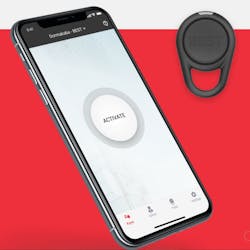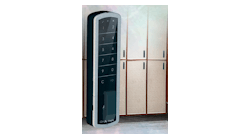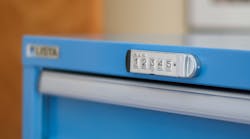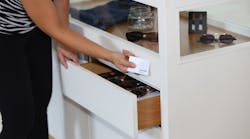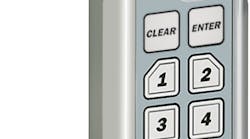Your customer simply wants to replace his lost desk or drawer key. This simple desk-key job can blossom into a series of replacement keypads or a big electronic upgrade when you offer the right solutions to your customer’s problems. The best sales advice I ever got was to keep my mouth shut and find out what was on the customer’s mind.
The big news is the rapid emergence of products enabled with Bluetooth Low Energy (BLE) and near field communication (NFC) that use a customer’s existing mobile credential. As with everything else electronic, the challenge is to match your skills and trusted products with customer demands.
In this article, we’ll explore some emerging technology trends, functions, hardware types and resources. One caveat: Before recommending any solution, verify what additional support equipment might be required for a functioning system.
Electronic miniaturization and longer battery life have led to practical electronic locks for desk and furniture applications. Access can be granted by three methods:
- What you know (for example, a password).
- What you have (for example a “valid” credential, such as a PIN, card, fob or smartphone).
- Who you are (for example, your fingerprint).
In some cases, this process is getting to be rather sophisticated, what with dual-authentication options available in mobile credentials.
Twin Technologies
The billions of cellphones in use today make this technology a major game changer. BLE and NFC are the two communications technologies built into cellphones since about 2011, and nearly all models have both.
There is an important detail you have to verify: What exactly does the mobile credential do? In many cases, your phone can be something you possess that grants you access via BLE or NFC transmission, and it also can verify that you’re the authorized user. In these situations, your mobile credential is the link between the lock and the network.
Cellphones also are used to carry information to and from keys, to update or interrogate readers or to store information, but they might not actually open the door. When you talk about mobile credentials, BLE or NFC, be sure you understand what actually is being done.
Each technology — BLE or NFC — has its niche, and each is likely to be around for a while. NFC is a radio-frequency ID (RFID) technology, running on the 13.56-megahertz (MHz) frequency. It has become a popular retail payment vehicle, because the read distance is just a few centimeters. Transmission speeds are about 424 kilobits per second. Higher ultrahigh-frequency ranges might be added in the future.
NFC has been popular on college campuses, where young people might use Apple Wallet or Google Pay apps. Several access control suppliers are leveraging this technology to establish market positions in the college market.
BLE is a more recent development, allowing read ranges to be adjusted from about two feet to 30 feet (and more), depending on end-user settings. Extremely low-energy consumption allows for long battery life. The system operates a spread spectrum protocol at 2.4 gigahertz, and transmission speeds run from 1 to 3 megabits per second. BLE allows for multiple high levels of encryption in the locking device, in the transmission package and in the mobile credential’s application. BLE and NFC systems use increasingly high levels of chip security.
We’re seeing rapid adoption of BLE technology in the access control market, with almost daily product announcements. The easiest electronic upgrade for desk, furniture and cabinet locks is with existing small-format interchangeable core (SFIC) housings. Many thousands of desk and cabinet locks in larger organizations are equipped with SFICs that allow the organizations to keep up with dynamic daily organizational changes.
SFIC Options
SFIC housings are found in drawers and cabinets of numerous educational, military, industrial and transportation facilities. They proliferate in car-rental and airline service counters, particularly at airports.
For example, the BEST Switch Core drops into any SFIC housing with no modification, providing immediate access control via the user’s mobile credential. Another recent entry is Salto Systems XS4 GEO mortise cylinder and cam locks. The company is developing a broad access control product line that will include European and U.S. card standards, plus NFC and BLE applications. Expect many other brands to enter the mobile-credential market in upcoming weeks and months.
Olympus Lock now offers cabinet lock conversion kits for Salto electronic rim cylinders and other standard rim cylinders. These conversion kits enable you to convert standard U.S. rim cylinders into a latch or deadbolt cabinet lock.
Medeco, with its XT series, and CyberLock have developed a wide range of cabinet, furniture and desk lock adaptations for their electronic keys. These proven products are well-known and trusted within the industry and are available for SFIC and large-format interchangeable core locks. Both systems have mobile-credential options to communicate with a network.
Keypad Operation
Keypad operation is the most prevalent option among desk and furniture locks today. The vast majority of the products on the market consist of battery-operated cam or latching (slam) locks that can be surface-mounted or mortised into wood drawers. Most fit into existing three-quarters-of-an-inch desk cutouts with only a small additional through bolt for stability.
Desk and furniture locks that have keypad operation are available from several companies, including CCL’s i-LOCK line, FJM’s Combi-Cam, the HES KP20, LockeyUSA’s GE370 Gemini, Lowe & Fletcher’s Gemini 3700 and the TriTeq MicroIQ. The CompX RegulatoR is also available, with audit-trail capability.
RFID cards and fobs also are integrated in several brands. The HES K20 and K100, FJM’s Combi-Cam E, Codelock’s KL1100, and Lowe & Fletcher and Lockey models are available with card or fob operation.
A variety of card types are on the market, including 125-kilohertz (KHz) prox, 13.56-MHz MIFARE, DESFire and HID multiCLASS SE card technologies. Verify the frequency and card protocols if integrating with existing systems. An upgraded Combi-Cam E from FJM now is available for prox card, fob, NFC or BLE mobile-credential operation.
Desk Lock Challenges
Office furniture often has been a challenge, because each desk manufacturer tends to have its own system with respect to mountings, drivers or retainers. TriTeq makes the MicroIQ desk lock with drivers specific to popular desk-drawer locks. These can be configured to Herman Miller, Haworth, Knoll, Hudson, Kimball, Timberline, HON (Allsteel), Wesko and Steelcase models.
Spring-latch or cam-lock versions also are available. These can be installed in minutes. In addition to keypad operation, 125-KHz, 13.56-MHz, NFC and BLE options are available. The MicroIQ is an aesthetically pleasing and easy-to-install system.
A major market opportunity has emerged in employee and club lockers. Modestly priced and easily installed keypad locker upgrades have become a good market for many locksmiths.
Externally controlled products, such as ASSA ABLOY’s HES K100, K200 and K600 series, can be integrated into existing electronic systems or networks. The K100 and K200 drawer and cabinet locks are battery-powered or hardwired.
dormakaba’s RCI MEM4400 mini lock is designed expressly for tight drawer clearance. The RCI 3500 series and Schlage’s 442S fit a wide variety of internal drawer or cabinet mounting configurations. These three manufacturers provide a solid variety of externally controlled 12/24-volt internal locking devices for electronic access system integration. RCI and Securitron offer lines of minimagnets for drawer and cabinet applications as well.
High-end retail stores have to keep valuable merchandise firmly secured in aesthetically pleasing drawers. Drug storage, personal files, valuables or records often require discreet protection as well. Accuride is a global player in sliding-drawer hardware. The company developed the Senseon locking system to allow concealed locking hardware. The creative design uses a concealed lock to capture the drawer slide.
The Senseon lock is connected to a prox reader near the front interior of the drawer. A concealed hub connects the reader to a power supply and the lock. Auto open, soft close and other slide options are available. The new Senseon Plus has audit-trail software.
CompX Security Products also provides the concealed StealthLock. This battery-powered device is installed easily in most wood drawers or cabinets within minutes. A nearby keypad provides RF communication to several locks within a 15-foot range. These are popular for lockers, desk drawers, office furniture and display cabinets.
Most of the products discussed here are available through your trusted lock distributors. The links below will take you to manufacturer’s websites. I like to build electronic files for each supplier, so I can look up brochures, instructions, photos and contacts quickly.
For More Information
BEST: www.bestaccess.com
CCL: www.cclsecurity.com
CompX: www.stealthlock.com
Cyberlock: www.cyberlock.com
FJM Security Products: www.fjmsecurity.com
HES: www.assaabloyesh.com
Lockey: www.lockeyusa.com
Lowe & Fletcher: www.loweandfletcherinc.com
Medeco: www.Medeco.com
MicroIQ: www.microiqlock.com
Olympus: www.Olympuslock.com
Rutherford Controls (RCI): www.dormakaba.us
Salto: www.saltosystems.com
Schlage: www.schlage.com
Senseon: www.senseon.com
Cameron Sharpe, CPP-Life Certified, worked 30 years in the commercial lock and electronic access industry. Email him at [email protected].
